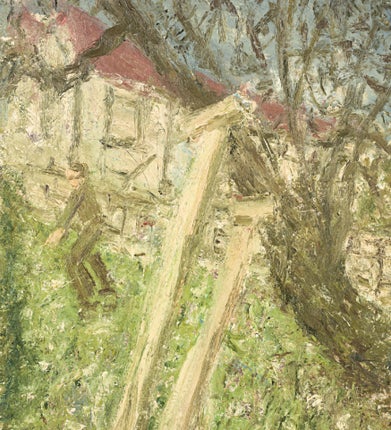Leon Kossoff, Annely Juda Fine Art, London

The painter Leon Kossoff, who is currently working with some vigour through the particular challenges of his ninth decade, has never been an artist who has readily engaged with nature. What do we know him for then? Portraits filled with existential anguish, often of a sitter (or sitters – he often paints pairs) that he has known for decades; railway junctions, chock-full of the fever of their characteristic comings and goings; building sites; street scenes; the occasional wild patternings of a teeming public swimming pool. And, a far graver and more sober theme altogether, the teetering, vertiginous grandeur of Christ Church, Spitalfields, which he has painted over and over again. Where has nature been in all of this? Little present is the answer.
Now, all of a sudden, she is vibrantly present. Kossoff's new gallery show – the first of its kind in a decade – has at its centre a range of studies, in oils and charcoal, of a cherry tree marooned in a London garden. It is not a healthy tree. We see it supported by two hefty wooden crutches, like the under-arm supports a lame man from some biblical scene might have used as he hobbled towards Jesus.
Trees have often been symbols much loved by poets – the mighty oak of England fallen, that sort of thing. Is Kossoff's cherry tree such another? Yes and no. The very fact that he is painting it now, in old age, turns it into a symbol almost in spite of itself. Is he not fighting – like this dying tree – against all the odds?
He has painted it at different times of the year, and each time the tree has been invested with a slightly different character. In spring, the tree looks quite robustly particular, on the verge of renewing itself again. At other times, it melts into the background of the garden in which it survives, becoming an almost abstract thing. Sometimes we see it in the company of a man or a girl, a house or a passing Tube train – this is a tree in an urban situation after all. Always it is painted hectically.
This is the mood of these paintings: busy, almost frenzied in their making. Dollops of paint are pushed around. There are rapid cross-cuttings of strokes, muddy loops and swirls. Sometimes it looks like fast sword play. All of a sudden we detect, on the outermost surface of one or another, the tiniest and thinnest dribbling of white. All these very characteristic gestures help to energise the surface, to keep the eye restlessly in motion. It is as if the eye is moving across hot coals. Kossoff seems to be punishing the boards against – not on, but against – which he works. These boards are rough-edged. They have the air of things that are accustomed to being put through their paces, quite brutally. The marks he makes, as ever, are ferocious, never settled.
At some point, the painting is abandoned; a truce of sorts is declared. We sense that to declare a painting finished is no easy matter for Kossoff. He always seems to be working at the chilly outer edge of his own capabilities, pushing himself in the hope that there is a tiny bit more that might be squeezed out. That final, defining touch, perhaps...
Looking at these paintings is an exhilarating experience, but it is never a restful one. Kossoff's tree is not at rest. It is fortunate to be heroically alive. Just.
To 17 December (0207 629 7578)
Join our commenting forum
Join thought-provoking conversations, follow other Independent readers and see their replies
Comments